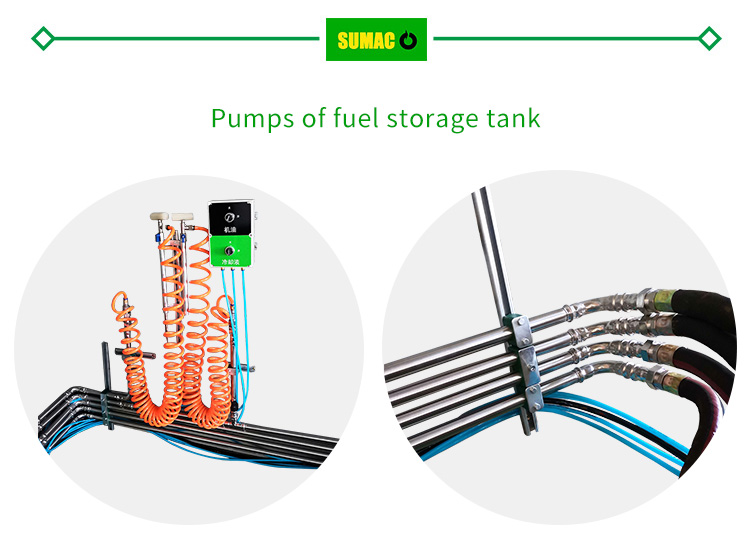Static electricity in diesel fuel tanks poses a significant safety risk, as it can generate sparks that ignite fuel vapors, leading to fires or explosions. Implementing effective prevention measures is crucial to ensure operational safety. Here are key strategies to mitigate static electricity hazards in diesel fuel tanks:
1. Grounding and Bonding
Proper grounding is the most fundamental preventive measure. Connect the fuel tank to a low - resistance ground system using a flexible, conductive cable. The ground connection should have a resistance of less than 10 ohms to quickly dissipate static charges. Additionally, when transferring fuel between tanks or vessels, use bonding cables to equalize the electrical potential between them. This prevents the formation of a voltage difference that could cause a spark during fuel transfer. Regularly inspect grounding and bonding connections for corrosion, damage, or loose fittings, as these can compromise their effectiveness.
Proper grounding is the most fundamental preventive measure. Connect the fuel tank to a low - resistance ground system using a flexible, conductive cable. The ground connection should have a resistance of less than 10 ohms to quickly dissipate static charges. Additionally, when transferring fuel between tanks or vessels, use bonding cables to equalize the electrical potential between them. This prevents the formation of a voltage difference that could cause a spark during fuel transfer. Regularly inspect grounding and bonding connections for corrosion, damage, or loose fittings, as these can compromise their effectiveness.
2. Control Fuel Transfer Rate
The speed at which diesel is transferred into the tank affects static charge generation. Faster flow rates create more friction between the fuel and the transfer pipes, leading to increased static buildup. Limit the initial filling rate to no more than 1 m/s, and once the fuel level covers the intake pipe, gradually increase the rate but keep it below 5 m/s. Using flow restrictors or variable - speed pumps can help maintain a controlled transfer rate.
The speed at which diesel is transferred into the tank affects static charge generation. Faster flow rates create more friction between the fuel and the transfer pipes, leading to increased static buildup. Limit the initial filling rate to no more than 1 m/s, and once the fuel level covers the intake pipe, gradually increase the rate but keep it below 5 m/s. Using flow restrictors or variable - speed pumps can help maintain a controlled transfer rate.
3. Use Anti - Static Additives
Anti - static additives can be added to diesel fuel to increase its electrical conductivity. These additives reduce the ability of the fuel to hold a static charge by allowing charges to dissipate more quickly. When selecting additives, ensure they are compatible with the fuel and the tank material. Follow the manufacturer's recommended dosage, as over - or under - dosing can be ineffective or cause other issues.
Anti - static additives can be added to diesel fuel to increase its electrical conductivity. These additives reduce the ability of the fuel to hold a static charge by allowing charges to dissipate more quickly. When selecting additives, ensure they are compatible with the fuel and the tank material. Follow the manufacturer's recommended dosage, as over - or under - dosing can be ineffective or cause other issues.
4. Tank and Pipe Material Selection
Choose conductive materials for fuel tanks and transfer pipes. Metals like steel or aluminum are inherently conductive and help dissipate static charges. If using non - conductive materials such as certain plastics, ensure they are treated with anti - static coatings or incorporate conductive elements. Avoid using materials with high electrical resistance, as they can trap static charges.
Choose conductive materials for fuel tanks and transfer pipes. Metals like steel or aluminum are inherently conductive and help dissipate static charges. If using non - conductive materials such as certain plastics, ensure they are treated with anti - static coatings or incorporate conductive elements. Avoid using materials with high electrical resistance, as they can trap static charges.
5. Maintain Clean Tanks and Filters
Contaminants in the fuel, such as water, sediment, or rust, can increase static charge generation. Keep the fuel tank clean and regularly drain any accumulated water. Use high - quality fuel filters to remove impurities from the fuel, as clean fuel generates less static electricity during transfer.
Contaminants in the fuel, such as water, sediment, or rust, can increase static charge generation. Keep the fuel tank clean and regularly drain any accumulated water. Use high - quality fuel filters to remove impurities from the fuel, as clean fuel generates less static electricity during transfer.
6. Personnel Training and Safety Protocols
Educate all personnel involved in fuel handling about static electricity hazards and preventive measures. Establish strict safety protocols, including the use of anti - static clothing and footwear, and prohibit smoking or using open flames near fuel tanks. Ensure that workers are aware of the proper procedures for grounding and bonding equipment before fuel transfer operations.

Educate all personnel involved in fuel handling about static electricity hazards and preventive measures. Establish strict safety protocols, including the use of anti - static clothing and footwear, and prohibit smoking or using open flames near fuel tanks. Ensure that workers are aware of the proper procedures for grounding and bonding equipment before fuel transfer operations.

